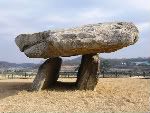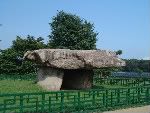☆ 002 ; cycle and story



As was mentioned in class on Wednesday, there may [or may not] be a sort of worldwide pattern during the Prehistoric age concerning the first forms of architecture, especially in an East-West sense. I couldn't help but recall the long discussions we had in my premodern Korean history class at Yonsei University about Bronze Age Korea and the appearance of dolmens, which are stone structures that consist of two to three vertical stones covered by a horizontal stone. While they're found throughout Europe and Asia, the highest concentration is found in Korea, where 40-50% of the world's dolmens are located.

The highest concentration of dolmen occur at Gochang in North Jeolla province, which is in the southwestern portion of the country. It is suggested that, perhaps like Stonehenge, some sort of burial rites occurred here, or they were tombs for society's elite. Most interestingly,
Dolmen are found in clusters of at least three or four, sometimes in groups of thirty or forty, and in rare cases of over one hundred, built in orderly array along a straight line--all of which suggests that their construction was organized and sustained over time.
[Korea Old and New: A History]
Not any societies can accomplish such a feat. The building of dolmens, and other structures such as Stonehenge, shows that the societies that erected them were stratified enough that there were elite at the top who could command a large labor force. I believe this is important to recognize as it sets the stage for further development within a society; societal roles are assigned to people of the different classes, and as a society grows it can produce a number of artifacts, which then become a cultural-historical backdrop as time passes. It becomes their language for how they understand themselves and their environments. I suppose you can say it's self-perpetuating.
-----
While in Seoul, I also did all the touristy things and visited many museums, one of which featured the following on its grounds:

This is a replica of the first efforts to create shelter, which were constructed and used during the Neolithic and Bronze Ages. While this one was located on the grounds of the National Folk Museum of Korea near Gyeongbokgung Palace in the northern half of the city, the most famous site featuring these structures was found along the Han River on the southern half of the city at what's known now as the Amsa Prehistoric Settlement Site. Archaeologists were able to date the site back to the Bronze Age due to the many artifacts they found that were indicative of that time period [especially pottery]. The materials used to create these spaces are fairly impermanent, like its European counterparts who used animal skins. Material is surely indicative of place, as you use what you can easily get, and showed how closely related people were to their site[s], as well as the other artifacts found [tools], which begin to paint their rich story.


0 Comments:
Post a Comment
Subscribe to Post Comments [Atom]
<< Home